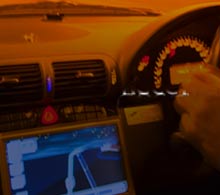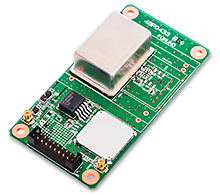Articles for ITS market
TOYOTA Press conference about ADAS
- Releasing algorithm for "sudden acceleration suppression during attempted sudden acceleration" free of charge -
Response to elderly driver accidents
In early February 2020, the Public Relations Department of the Toyota Head Office sent an e-mail saying, "I'm in a hurry, but could you attend a press release on ADAS?"
ADAS (Advanced Driver Assistance System). Generally, it refers to a preventive safety device that uses in-vehicle sensors such as cameras and radar. Which controls a collision damage mitigation brake called an automatic brake.
In recent years it has been designed to deal with elderly drivers, who have experienced a series of serious accidents.
Seigo Kuzumaki, a fellow at Toyota's Advanced Technology Company, which conducts research and development on ADAS and automated driving, explained in detail.
At the beginning of the explanation, various graphs and data were presented regarding the social issues and background that led to this announcement.
The biggest reason for the increase in elderly driver accidents relates to the increasing number of elderly drivers. According to the National Police Agency, when compared 2007 to 2018, the number of licensed driver groups aged 75, 80 and over almost doubled.
As an additional note, the rapid aging of licensed drivers was attributed to the continued spread of private cars in Japan during the high economic growth periods of the 1960s and 1970s. Currently in 2020, 1970 was 50 years ago and those in their 20’s are now aged in their 70’s.
In terms of gender it is about a 10 to 20-year delay for women to get a driver's license in Japan than for men. Therefore, in the 2020’, the number of elderly female drivers will increase and it is certain that the total number of elderly drivers will also increase.
Given this social situation, Toyota has taken measures.
The continuously-evolving Toyota ADAS
Toyota's ADAS is called “Toyota Safety Sense”. The technology is upgraded once every few years, and most recently in 2018 The accuracy of in-vehicle cameras and millimeter-wave radar has been increased to protect pedestrians at night.
Toyota Safety Sense, starting in 2020 will mass-produce a system that detects an oncoming vehicle going straight and sounds a buzzer inside the vehicle when turning into its path at an intersection. It will be installed on the new Yaris (formerly Vitz) released in February 2020 and will be used on other models as needed. In the near future, Toyota Safety Sense will be equipped with a collision avoidance function with automated steering that is mass-produced with the Lexus Safety System + A.
In addition, Advanced Park which provides parking assistance will be mass-produced with increased accuracy. The on-board camera and infrared sensor, senses 360 degrees around the vehicle and controls the steering, accelerator, and brakes to shorten the time required for parking. In addition, the operation has been renewed with an emphasis on easy-to-understand operation and the content displayed on the in-car monitor has been revised. I participated in a prototype test drive of a new Yaris in Chiba Prefecture in December 2019 and experienced the new advanced parking with an actual car.
An algorithm for sudden acceleration suppressing at attempted sudden acceleration is released free of charge
Next, Mr. Kuzumaki explained the sudden acceleration suppression function during a sudden acceleration.
In a nutshell, it is an "accelerator and brake misstep prevention device" that utilizes big data.
Accelerator and brake confusion often occurs with elderly drivers. In the past Toyota Safety Sense used a camera and millimeter-wave radar to control the engine speed so that it would not increase even if the accelerator was suddenly depressed when there was an obstacle ahead.
In other words, the vehicle only responded when it was stopped.
However, when Toyota analyzed actual accident cases it was found that there were many cases where the driver accidentally depressed the accelerator and brake while driving.
There is a significant technical hurdle for automakers to intentionally create a situation in which the car does not accelerate when the accelerator is depressed while driving.
On top of that, Toyota has developed a unique algorithm based on the driving data collected from the Data Communication Module (DCM) that transmits the in-vehicle data to the cloud (big data) already installed on each model.
According to this algorithm for example, when the vehicle turns at an intersection with oncoming traffic, it senses an unnaturally sudden accelerator operation is performed and controls the engine speed so that it does not increase. The technical details will be disclosed free of charge to other automakers to promote integration into their systems.
Toyota will use the acceleration suppression function during sudden acceleration attempts in all models to be released after summer 2020. In addition, functions will be added to the optional accelerator and brake confusion prevention device that is sold as a dealer option.
To use, an optional setting key is provided to distinguish it from the normal Toyota Safety Sense mode.
Pricing has not currently been disclosed.
Writer introduction

Mr. Kenji Momota Automotive journalist
His major is the world automotive industry and he is also familiar with the energy industry, IT and the aging society problem as the related fields. He acts around the world based in Japan and USA and writes for the general magazines, the technology journals and the automotive related media etc.
He is also commentator of motor race and world's motor show on TV program based on his career of the driver of Indy Racing League and NASCAR. In recent years, he has been covering about a paradigm shift from developed countries to developing countries, the motorized vehicle like EV and the telematics.
FURUNO ITS Journal
Click here for the latest articles after 2022 (in Japanese)2022
- The "realistic" self-driving roadmap shown by the Japanese government and a hands-on report on the latest Subaru EyeSight X
- Will FCVs (Fuel Cell Vehicles) Become Popular? ~New Movement in Toyota and Honda~
- The 'Complete' online sales of new cars start in Japan. Will this new way of buying cars take root?
- Many Firsts! On-Site Report from Tokyo Auto Salon 2022 - The author, who knows what goes on behind the scenes, looks back on 40 years of history. -
2021
- "Moving toward zero traffic fatalities for four-wheeled and two-wheeled vehicles globally in 2050" ~Experience on Honda's latest safety technologies~
- Tsuneishi Shipbuilding's building and DX, an exclusive visit to the main factory
- Japan's Smart City: New Moves toward Practical Use
- When will self-driving buses (service cars) be put to "full-scale" practical use?
- Utilization vehicle data during disasters
- Toyota-led Connected Technology to Transform Commercial Vehicle Business -From light trucks to large trucks and buses-
- Toyota enters the connected car "Personalization" business
- Japanese automakers' carbon-neutral strategies swept up in ESG investment
- Drive experience of the latest autonomous vehicle models and advanced driving support systems
- Will carbon neutrality accelerate the trend to strengthen LCA (Life Cycle Assessment)?
- Semiconductor shortage exposes realities of the automotive industry
- Online Autonomous Driving Contest Enhancing development of Human Resources
2020
- What happens to CASE when gas cars are banned in Japan?
- When will Flying Cars be launched?
- Expectation vs. reality:Autonomous Driving in Japan
- V2X, Becoming increasingly important in autonomous driving
- Technology of Subaru “EyeSight X”
- Lifestyle-oriented French cars gain popularity in Japan
- Human-oriented smart cities are wanted
- MaaS and CASE, how would automotive industry change after COVID-19?
- The beginning of virtualization era, triggered by COVID-19
- Trend of EV shift and consumer demands
- TOYOTA Press conference about ADAS - Releasing algorithm for "sudden acceleration suppression during attempted sudden acceleration" free of charge -
- The Japanese automotive industry in 2020 - 3 turning points -
- "Using a smartphone while driving" and "Level 3 automated driving"
2019
- Motor show business model is at a turning point - Tokyo Motor Show Report -
- Commercialization and monetization of MaaS - ITS World Congress Singapore Report -
- Android Automotive pays attention to V2X - Report from the Frankfurt Motor Show 2019 in Germany -
- Automobile Distribution Revolution and DCM (Data Communication Module)
- Connected business potential and newly proposed "eMaaS" by Honda
- 5G services for practical use are multiplying
- Connectivity technologies attracting attention due to frequent traffic accidents
- Shanghai Motor Show report -SUV, EV, Automated car & 5G-
- Drone Business roadmap and updates to Michibiki (Quasi-Zenith Satellite System)
- MaaS (Mobility as a Service) "town development." Full-scale promotion for a national project
- CES organizer states "Data Period in 2020s." Transformation of the Automotive Industry in CES, US "-CES2019 Report-"
- "Return to Origin" directed towards the age of change, automatic operation and connectivity
2018
- New proposal for Private Car Automated Driving Level and other Hot 5G Technology Topics
- Standardized EV charging infrastructure concerns in Europe, US, Japan and China - Kobe EVS 31 field report -
- Touring a pure car carrier and a test drive of the latest hybrid car
- Planning stage products are exhibited at the newly established visualized mobility service "TOYOTA MOBILITY SHOWROOM".
- Potential “Community Car-share” program promoted by local residents
- CES Asia Report 2108
- Companies attempt new Vehicle-to-Infrastructure communications, including traffic volume measurements and vehicle positioning. -ITS Asia Pacific Forum in Fukuoka-
- Geneva show in Switzerland. Flying cars and MaaS (Mobility as a Service) were hot topics.
- EV (Electric Vehicle) proposals by country
- MaaS competition through service mobilization, M & A and technical field collaboration is accelerating. - The CES 2018 Report -
2017
- Big data’s initiative and fight for the automotive industry. Cooperation among companies becomes increasingly important.
- Connected car and road-to-vehicle communication automatic operation
- ETC (Electronic Toll Collection) and ETC2.0. Current situation and projected future
- Rapid development of sharing economy
- Germany is first to recognize level 3 automated driving
- ITS EU 2017 Field Reports -Automatic Operation and the eCall-
- From Infotainment to ITS, the competitive area is spreading in the car big data industry.
- GTC (GPU Technology Conference) Report and the de facto standardization of AI (artificial intelligence)
- Renesas' new challenge! "e-AI Solution" and "Renesas Autonomy"
- The Automobile industry is shifting from a manufacturing industry to a service industry.
- The movement toward accident countermeasures for aging drivers in Japan
- Fusion of ride sharing and fully automated driving is advancing in the USA.
2016
- Overview of the Quasi-Zenith Satellite System (QZSS) and advancements toward full-scale practical use including the Tokyo Olympic Games - G-space EXPO 2016 report-
- Japan’s automated driving project "SIP-adus" will be a large demonstration experiment.
- The International Home Care & Rehabilitation Exhibition. There were many car manufactures with exhibits booths at this show.
- Japanese car manufacturers starting to concentrate on strengthening the ADAS system
- A new movement of legislation for autonomous cars
- Cyber Security and “AGL”, the new OS for automotive are hot topics in the connected car industry
- “High precision 3D map” the key future of autonomous car and pedestrian dead reckoning
- Chinese “BAT” is accelerating their business in the EV (Electric Vehicle) market
- Tesla's original connection to Taiwan and the new transportation system technologies.
- "The main topic" of the Geneva Motor Show was how to strengthen "pedestrian protection"
- The probe data business is getting more competitive
- Reporting directly from the 2016 CES show "Data services will soon become the main revenue source of automotive industry"
2015
- Do the automated driving systems need the GNSS (Global Navigation Satellite System) ?
- ETC Version 2.0 is coming soon. A new service was announced at the Tokyo Motor Show and the possibility that is could be used as a device for older drivers.
- "Connected Horizon" and "eHorizon". Germany's leading parts supplier accelerates strengthening of "Big Data" for business



 Mr. Seigo Kuzumaki, Fellow of Advanced Technology Company explained at Toyota Head Office
Mr. Seigo Kuzumaki, Fellow of Advanced Technology Company explained at Toyota Head Office Technology display of the new Yaris. Equipped with next-generation Toyota Safety Sense function.
Technology display of the new Yaris. Equipped with next-generation Toyota Safety Sense function. Illustration of the acceleration suppression algorithm newly developed by Toyota
Illustration of the acceleration suppression algorithm newly developed by Toyota GPS/GNSS Receiver&Chips and Modules (positioning and timing)
GPS/GNSS Receiver&Chips and Modules (positioning and timing)